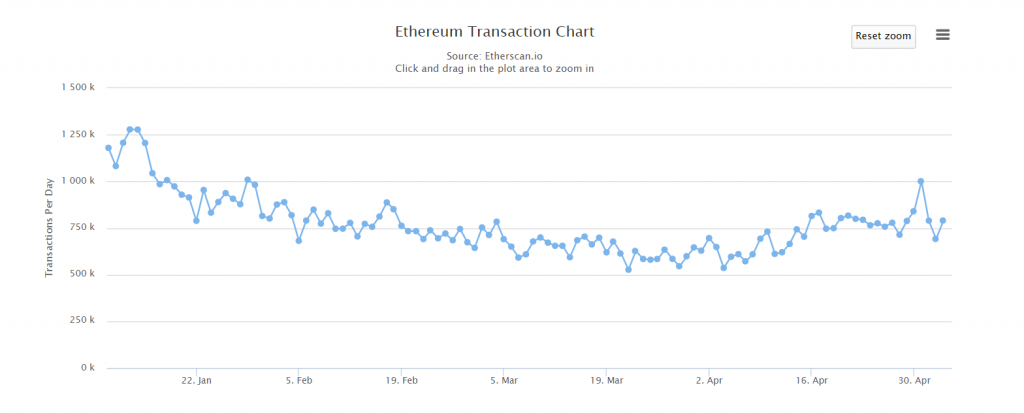
Remember Ethereum, that cryptocurrency which was supposed to fade out and get replaced by newer and shinier “Ethereum killers” from the crypto 3.0 generation? Well, it seems like the day when such flippening will happen is still quite far away, as the coin just recently reached 1 million transactions per day.
Last time this happened was in February 2018. Since then, the transaction number fluctuated from 500 thousand to 750 thousand regularly, somewhat following the Ethereum price along the way. Most recent jump over one million happened on May 4th, when a sudden increase of 200 thousand transactions was recorded.

Many people were left wondering what caused this explosion of transactions in such a short period of time. A twitter user epheph offered his two cents, wondering if Binance are “purposefully buying half of all transactions, while using bad startgas and leaving dust in tens of thousands of accounts.” To a question if he thinks that Binance was hacked, he responded by saying: “I don’t think so, I just think they are doing a very bad job of sweeping: wasting gas, DOSing network, and leaving 0.005 in all accounts”. To complete his explanation, epheph provided a link to EtherScan which proved that a single address, apparently belonging to Binance, was responsible for 50% of GAS spending for the day.

The following day,this spike turned out to be temporary and transactions returned to their normal levels.
An increase in daily transactions could cause trouble for the Ethereum. We all remember what happened when CryptoKitties were launched and how the entire network slowed down almost to a grinding halt. Currently the projected ceiling of the network is around 1.4 million transactions per day, with everything above threatening to completely shut it down.
Ethereum team aren’t sitting on their thumbs and waiting for the inevitable crash. In a reddit post, Ethereum developer Péter Szilágyi responded to the calls of Ethereum network not running as smooth as it should by saying:
“What you’re experiencing is not Geth (Geth is a multipurpose command line tool that runs a full Ethereum node implemented in Go) getting worse, but the Ethereum chain pushing the limits of what the existing codebase can handle. Two years ago the Olympic Ethereum network fell apart multiple times and clients couldn’t keep up syncing… that was 8GB in size, current Ethereum mainnet is 1TB for an archive node.”
All in all, many development teams are working hard on finding ways of increasing the maximum transaction load of the network. Once this maximum load is reached, transactions will have to battle it out between eachother to determine who gets into the network and who doesn’t. The only way they’ll have to fight this battle with is through transaction fees, meaning that GAS spendage and wastage will rise if network becomes overloaded.
Payment solutions like Truebit are suggested as a way of circumventing the network congestion issues. This, combined with Hybrid Casper and eventual sharding techniques that are being developed by Vitalik Buterin and his team, should in the future increase the maximum load Ethereum network can handle.








